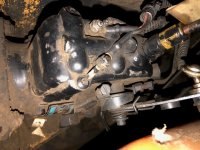Bern
Well-known Member
- Location
- Mount Vernon, WA
Hey there Dieseltech,
I have a Deere skidsteer with a little 2.9L four-banger in it. Said engine has a Stanadyne DB4 injection pump. We were using it the other day and everything was running great. Shut it down for lunch, came back and it would barely start and run. The engine WILL run, but only at about 400-500 RPM, barely. Nothing I can do on the outside will get it to run any faster than that. I barely have enough power to lift the bucket. It acts like something came disconnected inside the pump between the throttle arm on the outside and the metering mechanism inside. I have confirmed that the lever on the outside of the pump is connected to the throttle linkage and is rotating the shaft that goes into the pump. I have also confirmed that the lift pump is still working. It will run all day at 400 RPM.
I'm far more fluent with the CAV pumps than I am with the Roosie pumps. Have you ever seen something like that before, and/or can you speculate what went wrong? I'm hoping I can simply pop the top off and fix it without having to remove the entire pump. I plan to drill out the tamper-resistant Torx screws.
Full pump number if you're curious is DB4327-5658. Attached pic is as good as I can get due to the tight space. Thanks for any help you can be.
I have a Deere skidsteer with a little 2.9L four-banger in it. Said engine has a Stanadyne DB4 injection pump. We were using it the other day and everything was running great. Shut it down for lunch, came back and it would barely start and run. The engine WILL run, but only at about 400-500 RPM, barely. Nothing I can do on the outside will get it to run any faster than that. I barely have enough power to lift the bucket. It acts like something came disconnected inside the pump between the throttle arm on the outside and the metering mechanism inside. I have confirmed that the lever on the outside of the pump is connected to the throttle linkage and is rotating the shaft that goes into the pump. I have also confirmed that the lift pump is still working. It will run all day at 400 RPM.
I'm far more fluent with the CAV pumps than I am with the Roosie pumps. Have you ever seen something like that before, and/or can you speculate what went wrong? I'm hoping I can simply pop the top off and fix it without having to remove the entire pump. I plan to drill out the tamper-resistant Torx screws.
Full pump number if you're curious is DB4327-5658. Attached pic is as good as I can get due to the tight space. Thanks for any help you can be.


